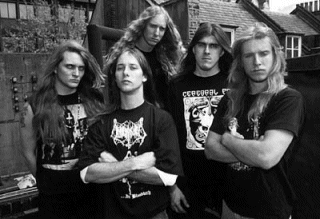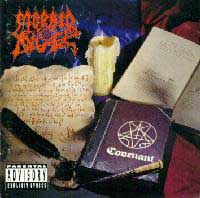Also:
No CommentsPasadena Napalm Division – P.N.D.

Pasadena Napalm Division – P.N.D.
This solid slab of “modern crossover thrash” tends more toward hardcore than 1980s thrash but shows the quirky influence of the three bands from which it draws members: DRI, Dead Horse and Verbal Abuse. Showing the evolution of metal since the 1980s, it has the tighter rhythms and more encompassing wall of guitars achieved with more precise tremolo.
In a nod to the NOLA music of the last two decades, it uses “riot vocals” where all band members chant and sing at once in infectious trope; from DRI it borrows the fluid rhythms and almost theatrical interruptions of song structure, but like later Dead Horse it tries to merge blues, rock, punk and metal into something more accessible. More like SOD than the original DRI, it features very much punk-influenced riffs that do not vary in shape or intensity as much, which makes for a more continuous listening experience. Vocal rhythms guide these songs which tend to be longer and more sociable in topic than the old thrash songs.
“P.N.D.” improves on the technical precision (or lack thereof) of older thrash, and by mixing in the death metal influences, makes this music hit more like a linebacker than a cynical kid zinging one-liners over the heads of the Responsible Authority Figures (RAFs) nearby. It’s good to hear Kurt Brecht when they let him do the vocal tracks alone, and he has lost none of his vitriol, but has more of a uniform delivery.
In fact, what makes this different from older punk and thrash the most is that it is more uniform in approach. Riffs are all strummed at the same speed and do not break for weirdness like DRI did. It’s hooky, with the melodic chants dominating the listener’s brain. The somewhat funky rock influence may turn off hardliners from the thrash days, but for listeners accustomed to newer hardcore, metal or swamp-groove metal this will be a powerhouse that may open their eyes to a wider world.
No CommentsRites of oblivion bathe in execrable light
Gontyna Kry – Welowie
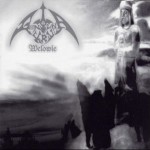
One of the best works of Polish black metal, Welowie has the craftmanship and melodic sophistication of Sacramentum’s best work but marginalizes the death metal influences, instead filling that loophole with the post-Discharge melodic hardcore that Graveland had a niche for carving out in their earlier work. Distant screams amidst a melancholic plethora of notational sequences reveal a sense of emotionally fraught catharsis not unlike a more musically ‘learned’ take on Mutiilation’s best works. The eight tracks on here run at just over 26 minutes in total but still in such a limited constraint manages to make the most of epic scope and artful expression within a time constraint that would more traditionally fit a death metal band. In some ways calling this work merely a ‘demo’ does it little justice. –Pearson
War Master – Chapel of the Apocalypse

A young Texan war squad shows you don’t need advanced technique or labyrinthine compositions in order to succeed at pulverizing death metal hostility, as the palm muted chainsaw grind slugs onwards with the determination of a German panzer advancing towards certain death upon the Stalingrad plains. As with most young death metal bands, their earnestness sets them apart from most of the older colleagues and the primitive, architectural weight of “Awaken in Darkness” convinces one of morbid intentions unlike a thousand Necrophagists. Dark atmospherics abound in these documents of fear and rage in chthonic shade, bringing reminders of Amorphis’ and Incantation’s early Relapse days , the five musicians being able to build a solid tribute to their influences on this demo and generate a fiendish excitement for a capable followup. The success of the band in creating an esoteric sensation out of their simple source material is worthy of praise. –Devamitra
Witchblood – Witchblood

As if possessed by the ritual thrall of Walpurgis night, this mostly solitary creation of an individual called Iron Meggido is a clash of smoothly feline aggression of Nordic Black Metal with the Romantic architectural use of Heavy Metal riffs that characterized the occult metal of Celtic Frost, Samael and Therion. Alongside the suggestive and provocative riff stand the invoking voice of an Erinys caustically timed with the bludgeoning tempi of guest drummer L’Hiver. Underlying the beauty of this demo is the illuminated fire of an artistic vision in its birth-throes, painfully struggling against the bounds of convention in order to express the ultimately inexpressible: the twilight zone of fever and mythos where the ‘supernatural’ influences the evolution of man and mind. Hopefully their talisman is effective in order for the legion of Witchblood to fly even higher on these wings of rapture.
–Devamitra
No CommentsTags: Black Metal, death metal, Mythology, Occultism, War Metal
Confusing social judgment with reality
I like this short essay in defense of Gonzo-style subjectivity:
So the concept of opinion here is strictly experiential – it is your vision of this record that is being sought and an interpretation unshackled by the influence of individuals exerting which records that are supposedly valid or true. To tap deep into the essence of why your chosen opus matters to you should render all other considerations redundant. My fundamental concern is for readers to be able to channel your vision and either discover an offering they hadn’t had the opportunity to prior, or at least determine an unconsidered perspective.
Pre-empting reader response is futile, they will extrapolate the messages as they see fit. Considering the likely audience for a publication such as Black Metal Revolution, it is naïve to consider it some sort of “rule book” or “guide to BM for the uninitiated” as there is no prescribed list of the records that should and should not be included. There are offerings I would like to see adorn the books pages, but this is not something I intend to contrive as it is at odds with the production’s essence.
A submission to BMR is a clear account of a record that matters to the author and why. Sure it can be more should you wish it to be. Some are better equipped than others to provide such an insight, though creative prowess is not necessarily a gateway to divination. VON is always going to appeal to me over some sort of pompous, overblown and overproduced act like Dream Theater; though try to explain to a Dream Theatre fan WHY that is the case is futile. The language of reverie is different for all individuals who are truly channeling their innermost. – Black Metal Revolution
None of the DLA’s critics have ever noticed this, but we have never been cruel to subjective opinion. We have only said that beyond the individual, it is unimportant.
We are nihilists. What matters to us are consequences in reality, not peoples’ feelings, perceptions, desires, emotions, aesthetics and so on. We are ultra-realists.
The fact is that some art stands above others; the counterfact is that this does not necessarily determine why you like it. Our goal is to find the art that stands above the rest. Otherwise, why both read a review? Who cares what the other guy likes, unless you’re looking for something to listen to, or a canonical depiction of a genre?
We all have some bands we like because we like them, not because we think they are good. For me, it is older punk bands, who now stand revealed in the light of experience. They are amateurish, sloppy and often redundant. Not all punk bands are this way.
In defense of VON, who we have listed on the site, they like punk were an important step in removing the pre-conceptions of rock music from metal, especially black metal. They are also good, in a limited sense; they are probably not good for repeated listening, as musically, they are boring. No three magic notes exist which are so fascinating they trump complex melody; it’s basically rhythm and arrangement at that point which determine the band.
As far as this listener goes, I like both Beethoven and Von — I recognize Von’s limited historical importance, and that Beethoven is objectively better than Von, and that to think otherwise is mental retardation. I still like Von.
No CommentsSupport the war… against hipsters
Interesting take on it:
I personally don’t want to label metal ‘underground’. I try to get my friends interested, but for one reason or another metal was meant to hold a limited audience. Which is fine because it has remained resilient through the years with such support. Exclusivity has become a defining pillar of the scene, the implications of which look dismal for the future of the genre.
{ snip }
My problem is not with ‘who likes metal’ but rather why they like metal and what the implications are for the genre.
Hipsters tend to take the honesty out of music because of how they rationalize their choices. People who respect their taste in music do not listen to bands because they are underground; they listen to them because they make good music. If a band gets too popular, they let it slide so long as said band remains honest. If said band loses their integrity, say Metallica, for instance, then one abandons them not for crossing some unspoken popularity threshold but rather because they have betrayed the trust of their fans. This is a powerful bond not easily broken by the likes of the mainstream press.
Hipsters, and I’m generalizing here, define their musical taste by what is unpopular; I’d even venture to say it is a defining pillar of hipsterdom (whatever that means). Metal has rare bouts of popularity but is unlikely to achieve mass appeal anytime soon, especially given the rigid parameters of top-tier saleability in the music industry. These impossible conditions leave metal with one possible future. Since the genre will not likely be rising to the mainstream popularity which could save it from a skinny-jean-clad audience (though I must admit that is pretty thrash) it is only a matter of time before the genre is completely saturated with hipsters. In San Francisco, metal culture has dwindled to only a handful of bands. – Sons of the Atom
The principle of hipsterdom is being different/ironic/”unique” through surface changes.
The hipster is at heart a very normal person, usually working a do-nothing job and living a boring life. Most are SWPLs.
They have, however, embraced failure. They aren’t doctors, lawyers or architects; they’re not even rogue programmers. They’re not real writers or artists. In fact, they’re not very good at anything. So they socialize and try to be “different” to stand out, since they’re not going to stand out for being good people, or smart people, or talented people. They’re faking it.
This is why they like music that’s basically bad: anyone can do it. If you trick it out enough, you get famous for it.
This is why they like ruined social scenes, failed things, and obscurity: they can take over.
They took over metal in 1999ish and have truly wrecked it, because metalcore is noomoo for underground hXc kids, and as a result it’s insipid trash.
Hardcore died in 1987 or before, and really has never come back. The hipsters want to think otherwise. Metal died in ’94.
It’s important to realize that hipsters are a sign of the end of all good things. They are the parasites who are trying to justify themselves into importance.
Supporting the war against hipsters is to support:
- Substance over appearance.
- Reality over social reality.
- Art over personal drama.
- Idealism over individualism.
All good things come from crushing the hipster, which is a force of decay.
Apple sold 9.25 million iPads and 3.95 million Mac computers. Gross margin for the quarter came to 41.7 percent.
Shares of Apple have emerged from the limbo they had fallen into after Chief Executive Steve Jobs took leave last January for unspecified medical reasons. – Reuters
Capitalist banksters, ganksters and toadies love hipsters because they will buy a bog-ordinary product with a special label and quintuple the margin on it. They are ideal consumers: morons who think they are right and can be easily led to buy something if it makes them feel unique and special.
Allah ta’ala will reward all those who give service in crushing the false (who don’t entry) and raising up the honest. Immortality and righteousness await all those who smite hipsters.
No CommentsDeath Metal FAQ
1. What is Death Metal?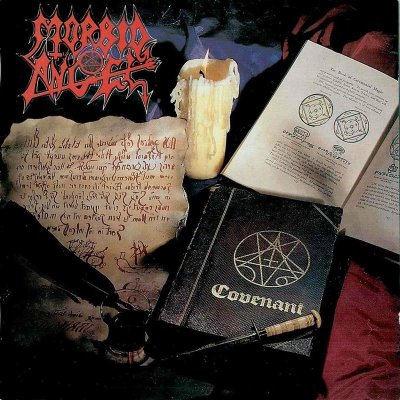
2. Who invented Death Metal and when?
3. Why do most Death Metal fans wear distinctive t-shirts?
4. How to understand Death Metal lyrics?
5. Why does Death Metal have such a morbid visual style?
6. Are Death Metal bands satanic or occultist?
7. Does Death Metal possess an ideology?
What is Death Metal?
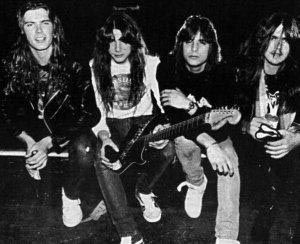 Death metal is structuralist heavy metal that borrows heavily from classical and industrial music. Its heritage is equal parts neoclassical heavy metal from the 1970s and hardcore punk from the early 1980s; if you throw Discharge, Judas Priest and King Crimson into a blender and set it on “high,” you might get something like death metal. It took from roughly 1983-1988 for death metal to fully evolve, and at that point, it experienced six golden years of fruitful growth before lapsing as black metal eclipsed it in popularity.
Death metal is structuralist heavy metal that borrows heavily from classical and industrial music. Its heritage is equal parts neoclassical heavy metal from the 1970s and hardcore punk from the early 1980s; if you throw Discharge, Judas Priest and King Crimson into a blender and set it on “high,” you might get something like death metal. It took from roughly 1983-1988 for death metal to fully evolve, and at that point, it experienced six golden years of fruitful growth before lapsing as black metal eclipsed it in popularity.
The original underground musical genre, death metal was completely unknown to most people until 1997 when it became fodder for mainstream commentary after several school shootings. During the 1980s and early 1990s, it was impossible to find death metal in normal record stores and chains; most people ordered it from small mailorder companies, or “distros,” that stocked underground metal exclusively. The underground in fact replicated every aspect of the normal music industry, including journalists and radio stations, to avoid being tainted by “commercial” or “mainstream” music.
We say death metal is “structuralist” because, in contrast to rock music, its goal is not a recursive rhythm riff that encourages constant intensity through verse-chorus structure; death metal, like black metal after it and prog rock and classical before it, uses “narrative” song structure, or a string of phrases connected in such a way that they effect musical and artistic change throughout the song. While rock music aims to find a sweet riff and ride it, and much of older heavy metal does the same, death metal is like opera: its goal is to use riffs to introduce more riffs, and through those, to create a treelike structure of motifs which resolve themselves to a final dominant theme. In this, death metal (like the progressive rock and synthpop bands that influenced it) is closer to classical music than rock music.
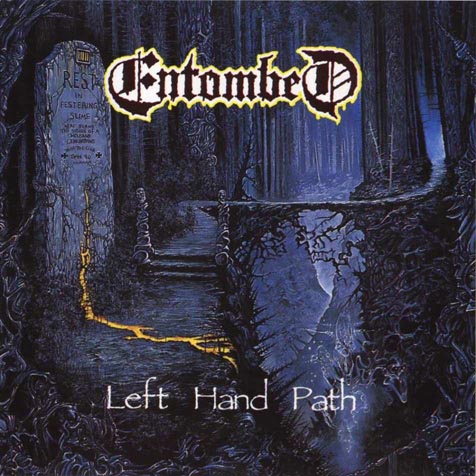 The history of rock music has been written by commercial promoters who have tried to establish its “authenticity” and uniqueness, and therefore, almost all mainstream publications are hostile to death metal. Death metal reminds us that rock music, blues and jazz did not arise autonomously in America, but were based on centuries of European popular music (the I-IV-V chord structure of the blues is derived from European folk music, and its “blues scale” is a modification of Asian and Celtic scales). Rock music is a scam, and its marketing makes it seem to be something greater than what it is, which is the same old music dressed up as a product. Death metal more than any genre before it broke from the rock tradition, and therefore is a threat to the rock establishment and its profits.
The history of rock music has been written by commercial promoters who have tried to establish its “authenticity” and uniqueness, and therefore, almost all mainstream publications are hostile to death metal. Death metal reminds us that rock music, blues and jazz did not arise autonomously in America, but were based on centuries of European popular music (the I-IV-V chord structure of the blues is derived from European folk music, and its “blues scale” is a modification of Asian and Celtic scales). Rock music is a scam, and its marketing makes it seem to be something greater than what it is, which is the same old music dressed up as a product. Death metal more than any genre before it broke from the rock tradition, and therefore is a threat to the rock establishment and its profits.
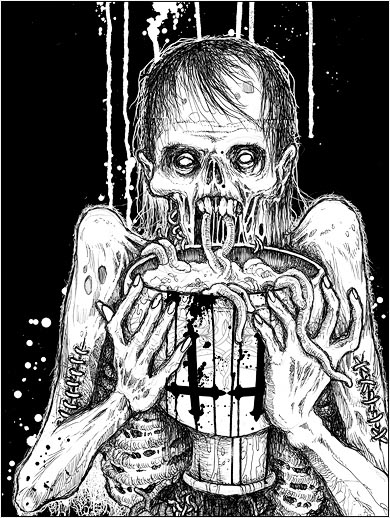 Like most musical genres in the modern time, death metal is constantly under assault not only from external interests, but from within, as self-interested people try to make rock music and dress it up as death metal. These attempts to simplify the genre would benefit those who attempt them, as they would both be able to make a saleable product (being similar to established musical tastes, it sells easily and broadly) and be able to claim the “authenticity” of belonging to an outsider form of art such as death metal. These false death metal bands have polluted the genre with the same mainstream dogma and musicality that death metal sought to escape. Like all human social breakdown, this breakdown occurs through the selfishness of individuals who are unwilling to admit that the health of the genre is more important than their personal profit.
Like most musical genres in the modern time, death metal is constantly under assault not only from external interests, but from within, as self-interested people try to make rock music and dress it up as death metal. These attempts to simplify the genre would benefit those who attempt them, as they would both be able to make a saleable product (being similar to established musical tastes, it sells easily and broadly) and be able to claim the “authenticity” of belonging to an outsider form of art such as death metal. These false death metal bands have polluted the genre with the same mainstream dogma and musicality that death metal sought to escape. Like all human social breakdown, this breakdown occurs through the selfishness of individuals who are unwilling to admit that the health of the genre is more important than their personal profit.
Death metal flourished from the mid-1980s to mid-1990s, and then was for most purposes replaced by black metal. Where death metal was structuralist with heavy emphasis on chromatic phrasing and hence rhythmic, black metal used narrative construction based on melody (an innovation of later and progressive death metal bands as well, such as At the Gates, Atheist, Gorguts and Demilich). As such, it is often hard to tell where death metal ended and black metal began, although in their mature form they are distinct genres. In this, and in the aesthetic components of death metal borrowed by mainstream bands as varied as Slipknot and Nirvana, death metal lives on.
References:
The History of Metal
Who invented Death Metal and when?
Death metal arose from the end of hardcore punk colliding with a desire to renew the spirit of metal; launched in 1969, proto-metal like Black Sabbath had become lost among hard rock (Led Zeppelin) and progressive rock (King Crimson) and needed redefining. The aggressive, oversimplified, and disconnected from contemporary music sound of hardcore punk was apt and therefore infused into heavy metal. In the process, because hardcore punk relied on streams of power chords or phrasal instead of rhythmic competition, metal became an entirely new animal.
This change can be heard first in speed metal bands like Metallica, Slayer, DBC, Rigor Mortis and Nuclear Assault. Phrases got longer, songs got more intricate, and the type of riffing that repeated a rhythm using a single chord got rarer; a new form of music was in the forging. However, these bands were still too entrenched in many of the rock-influenced tendencies of metal; death metal made a clean break from these. (It is interesting to note that the ultimate point of breakaway was thrash, or hardcore punk crossover bands who wrote punkish songs with metal riffs; these reduced music so much to its essence that it had to reconstruct itself, and having grand ambitions, reached toward narrative composition instead of the hackneyed rock styles.)
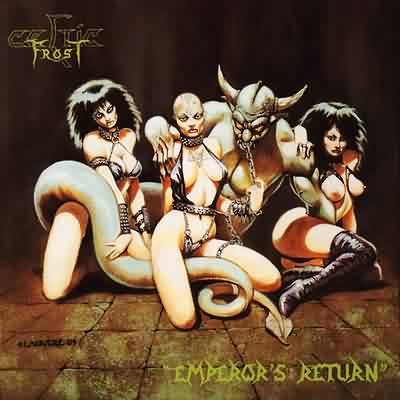 During the years 1983-1985, a style emerged that was between death metal, black metal and thrash, and from this all of the succeeding genres were to derive their musical inspiration. Bathory, Sodom, Hellhammer/Celtic Frost formed the basis of this style, augmented in the Americas by Possessed, Slayer and Sepultura. From these founding acts styles diversified into death and black metal. While many give credit to Venom for the term black metal, musically speaking they were rooted firmly in the heavy metal tradition.
During the years 1983-1985, a style emerged that was between death metal, black metal and thrash, and from this all of the succeeding genres were to derive their musical inspiration. Bathory, Sodom, Hellhammer/Celtic Frost formed the basis of this style, augmented in the Americas by Possessed, Slayer and Sepultura. From these founding acts styles diversified into death and black metal. While many give credit to Venom for the term black metal, musically speaking they were rooted firmly in the heavy metal tradition.
The golden years of death metal were from 1988 to 1994, during which time the classics of the genre and all of its variations formed. Percussive death metal thundered from the industrial east coast of America; Texas produced a harsh and grating otherworldly sound; Florida created the rhythmic and alienated Tampa style of death metal. Progressive bands from the USA and melodic bands from Sweden rounded out the style, as did innumerate hybrids, including doom metal and speed metal crossovers.
However, by 1994, the genre reached a decision point: where to go so as to keep up with black metal, which had expanded into melody as quickly as death metal had expanded into rhythmic structure, and now threatened to become more popular? The death metal genre had become calcified between diehards who insisted on a narrow definition of style, and “innovators” who wanted to make it into rock music, but both groups in their efforts to control external factors forgot internal factors, and the ideology and artistic spirit of death metal as lost. As such, it appeared senile and was forgotten for some years.
At the time of this writing, death metal is practiced by a few holdovers from the late 1980s who continue to put out quality music, but their numbers decline each year. The general health of the metal community is poor because it focuses on uniqueness of external appearance and not composition and artistic integrity. While we hold out hope for a death metal revival, it is more likely that it will simply take its place in history and we will be left with recordings.
References:
The History of Metal
Why do most Death Metal fans where distinctive t-shirts?
In the underground death metal subculture, the shirt you wear — bearing the logo of a favorite band or organization or concept — defines which strata of social accomplishment to which you belong within the death metal community. Your taste identifies your level within an intellectual hierarchy based on what its members are able to comprehend, or withstand, perhaps, musically.
For example, a guy in a Cannibal Corpse t-shirt might be neglected by someone wearing a Beherit t-shirt because Beherit has a more esoteric and theoretically-adventurous audience than the low-brow blockhead churning of Cannibal Corpse; t-shirts determine what bands your brain can accept and thus often, a type of caste identification within the hierarchy of fans. Those who try to forge this identity often find themselves answering difficult questions under unpleasant circumstances.
In the inverse situation, someone in an Atheist t-shirt might laugh off someone wearing a Sarcofago t-shirt as a philistine. This allows multiple communities to exist in a hierarchy within the death metal community and identify each other by sight, as well as differentiate metalheads from the hordes of drone normals who do nothing but buy Creed CDs and singing plastic fish.
How to understand Death Metal lyrics?
Death metal bands tend to use complex, Latinate language to describe the world in terms of its function and technologies, leaving the emotional terminology for rock music and blues. Its goal is not to affirm the emotions of the individual, but to point out the effects of structural change in the surrounding world. Not surprisingly, as a musical movement, death metal is also structuralist.
Unlike rock genres, there is a near total absence of gender words and love songs. Death metal is not about emotional escapism. Death metal is about reality.
Why does Death Metal have such a morbid visual style?
Symbols serve as an important anchor between the way a music sounds and what it represents aesthetically, including the ideas of the musicians as inspirational to their work. In death metal, there are several main categories of symbolism: the “occult,” the morbid, and the technological.
Death metal art — as seen on tshirts, album covers, flyers, patches, pins and stickers — includes all of these. The occult represents an opposition to morality; as a “nihilistic” genre, death metal musicians tend to be realists and recognize that no matter how much we classify something as morally bad or good, reality is unaffected, and whatever object is in question will serve reality at the level of function and not morality. The morbid represents another nihilistic outlook, which is that not only is death more real than our moralizations against it, but it will inevitably happen to us and we must be reminded by that. Where the occult uses pentagrams, ancient script, sigils and demonic imagery, the morbid uses disease, horror, submission and bodily corruption (including the mind/body turned against itself, as in zombie films) as its palette.
Technology makes an odd bedfellow with death metal art, as it is commonly used to modify one of the other two categories. Much as at the end of the Black Sabbath song “War Pigs,” Satan is shown as laughing and spreading his wings at the slaughter of young men for profit, technology is portrayed as amoral and therefore something that can turn on humanity at any minute. Combined with morbid imagery, we have art revealing human beings as both dependent on and captive of technology; combined with the occult, we have either technology in the power of the occult, or the occult as naturalistic and opposing technological humanity.
Art Death Metal bands satanic or occultist?
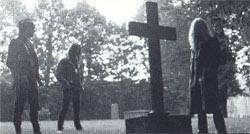 Death metal bands are occultist in that each of the founding bands and most to follow had an occult focus or research interest evident in their lyrics. However, few practise mysticism and most seem to use it solely as metaphorology for their works. This is convenient because our moral society, even when secular, bases its morality on Judeo-Christian mythology.
Death metal bands are occultist in that each of the founding bands and most to follow had an occult focus or research interest evident in their lyrics. However, few practise mysticism and most seem to use it solely as metaphorology for their works. This is convenient because our moral society, even when secular, bases its morality on Judeo-Christian mythology.
Any academic study of occultism in death metal must also take into account the range of occults employed. Judeo-christian, Babylonian, Far East, Nordic and indigenous American symbolism and ideologies appear in the lyrics and conceptual positioning of death metal bands.
References:
Satanism as Metaphor in Metal Music
Does Death Metal possess an ideology?
When heavy metal evolved in response to the hippie culture around it, it took darker themes to a new intensity and warned of apocalypse. Fifteen years later, speed metal bands were wailing about Armageddon. But as Aldous Huxley’s Brave New World is different from George Orwell’s 1984, death metal had accepted that the apocalypse would be a whimper, and not a bang, and that its progress was inevitable.
This paranoid and soul-wrenching logic created an immediate need to overcome the superstition and self-pity of a complacent age. In consequence, as if approaching Nietzsche’s “abyss” and going under instead of over, these bands have embraced a philosophy of nihilism and a delight in the intellectual, sensual and spiritual extremes of a dying age.
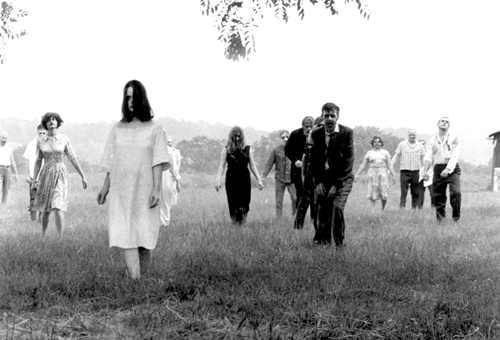 From this, much can be learned about a human future: nihilism frees us from much of our fear by confronting it head-on. Death metal bands have created an epic change in American subculture from one of morality to one of existential self-assertion, but further, the “gore” lyrics of many bands have targeted social denial of collective fear of death.
From this, much can be learned about a human future: nihilism frees us from much of our fear by confronting it head-on. Death metal bands have created an epic change in American subculture from one of morality to one of existential self-assertion, but further, the “gore” lyrics of many bands have targeted social denial of collective fear of death.
Ideology serves an important place in the generation of lyrics and concept to each band. for most, the personal is political in choice of music, intellectual aspirations within it, and values as expressed in themes of darkness, death, the occult, war, genocide and suffering. Death metal reflects a lineage to hardcore music, yet its heavy metal side shows in the use of the personal rather than collective as a means of communication.
That death metal has not collapsed on its own inertia, or become morality-driven and thus socially conformist like emocore or “life metal” bands, is a small miracle in a time of overwhelming commercial motivation to human efforts. Its underground remains strong and defiantly independent. As more people in society feel the need to withdraw from decaying mainstream values and behaviors, death metal’s ideology offers a glimpse of a nihilistic but impressively un-neurotic future.
References:
The Philosophical Tradition of Heavy Metal
Written by Vijay Prozak
2 CommentsTags: zine-zines
Celebrate blasphemy
The tantalizingly-named Blasphemy Day International is basically a thinly-veiled excuse to troll Muslims who were offended by cartoon caricatures of the Prophet Mohammed (PBUH); if you ask me, it’s kind of a shitty passive-aggressive way of going about this.
However, it’s also a good excuse for blasphemy, and we need more of that.
The holiday is on September 30. This year, why not:
I. Increase the Traditional Blasphemy
Our tribute to this is the Internet Altar of Unholy Blasphemy and The Christian Holocaust.
II. Force People to Accept the Genius of Paul Ledney
Not enough people know the sacred words:
Rip the sacred flesh
Sodomize the holy asshole
Drink the red blood of the mother of earth
Masturbation on the dead body of christ
The king of Jews is dead
and so are the lies
Vomit on the host of Heaven
Masturbate on the throne of God
Break the seals of angels
Drink the sweet blood of Christ
Taste the flesh of the priest
Sodomize holy nuns
The king of Jews is a liar
The Heavens will burn
Dethrone the son of God
God is dead
Holyness is gone
Purity is gone
Prayers are burned
Covered in black shit
Rape the holy ghost
Unclean birth of Jesus Christ
Heaven will fall
Fuck the church
Fuck Christ
Fuck the Virgin
Fuck the gods of Heaven
Fuck the name of Jesus
III. Extend this humanism, the secular form of populist religion
If we can blaspheme Islam and Christianity for being ignorant, how about humanism?
Humanism is the idea that humans are more important than reality, and that they’re all equal, and that their feelings matter.
The fact is that most humans are shitheads, and we want to celebrate the few good ones.
Spread this blasphemy:
- Use the R-word. Mock the retarded, kick cripples out of wheelchairs, rape the cowering, sodomize the meek, etc.
- Make fun of stupidity. It’s not polite to do this. Blaspheme! Do it.
- Mention overpopulation. People hate to hear about this. There’s too many of us, and not everyone can be special!
- Mock TMPR. Too Much Positive Reinforcement (TMPR) is “the belief, against all available evidence, that one is meant for Special Things.”
People hate it when you rape sacred cows, then cut their heads off and make them into burgers. Do it. With extra ketchup.
No CommentsKam Lee explains selling out
From a notoriously fractious and insightful source, a rant that nails it — on Facebook, of all places:
It’s from “formula” in metal music that has either been the downfall or the up rise in the genre and among many of the bands. When bands set a distinct genre – and a set “formula” is established, once those bands begin the mix or change that formula, is when they take a risk of failing.
Sure some newer fans may take to the new formula – but those already established fans in the formula have a certain “taste” for what they prefer. Change the ‘taste’ – take the risk of having the already established fan base spitting it out after the first bite. Sure, some will attempt to stick around and nibble at the edges… attempting to find a similair taste and familiar feeling…
They will even attempt to make excuses, attempt to rationalize it, and even go as far as to use controversial behaviors or feelings in an attempt to explain in a rational or logical manner their intrepid points. They wish to avoid any true explanation of the utter disgust and disappointment they are truly feeling, and thus hide behind pitiful excuses and whitewashed ideals and values.
However, in my opinion – when a band decides to forsake the formula that works, and forsakes integrity in exchange to gain “a piece of bread” (make $money) – I personally do not feel my loyalty is any longer of importance to the band. They have already decided that my personal opinion is no longer valid, and that other fans too that may share the same or similair opinions are also no longer important as well.
Integrity and pride more so than often get’s washed away in favor of the notoriety and tempting promise of “fame and glory”.
[…]
As well… with “formula” when a new genre is attempted to be made – by changing an already established genre, and trying to “mix” in something new to that genre. It is NOT likely to be accepted by those fans who already – as I said above – have an established taste for what the genre already has been dishing out.
Perfect example: DEATH-CORE is NOT DEATH METAL!
And as I said above –
some newer fans may take to the new formula – they will even attempt to make excuses, attempt to rationalize it…even go as far as to pretend to accept is as inevitable change.
Translating into cause->effect logic:
Formula means repeating what others did.
However, that “what others did” is an effect, not a cause.
The cause of what they did was the need to translate an idea/mood into music.
The effect was how they did it.
You can’t get the same effect by imitating their effect; instead, you must rediscover their cause.
But if your motive is fame/notoriety/kvltstatus/$$$ instead of “making art” (to translate that idea/mood into music), you will not understand that cause.
Metal is the spawn of early punk, progressive rock and horror film soundtracks — it’s more Anton Bruckner than Chuck Berry, more King Crimson than Blue Cheer, more Jethro Tull and Procul Harum than Led Zeppelin, and more Iggy Pop than The Beatles.
As a result, it takes integrity/authenticity seriously — it is music of the Idea, and by that I do not mean dogma or the reality-detached idea, but an enmeshment with reality.
Like Romantic literature, it is born of a time in crisis… it is mixed-blood, with some blood being the feel-good prole average (rock) and some being the rising above (ambitious music->art).
Romantic literature had both Shelley and Blake, after all. Wordsworth and Keats; Coleridge and Bram Stoker (later Romantic literature sort of diverged into Gothic lit).
What does it mean?
When metal loses its honest intent to create art, and to translate an idea/mood into music, it becomes window-dressing: pandering to the crowd for popularity points.
And then, it becomes the same callow manipulation we’re running away from, and that running away got us into metal.
Beware the rock-n-roll formula.
No CommentsInternational Day of Slayer — June 6, 2011

Celebrate the Inter-National Day of Slayer on June 6, 2011.
Slayer is an emblem of metal: fast, powerful, still alien to the mainstream after 28 years.
If every other religious, ethnic and political group gets their own holiday, we deserve one too.
How to Celebrate
* Listen to Slayer at full blast in your car.
* Listen to Slayer at full blast in your home.
* Listen to Slayer at full blast at your place of employment.
* Listen to Slayer at full blast in any public place you prefer.
DO NOT use headphones! The objective of this day is for everyone within earshot to understand that it is the National Day of Slayer. National holidays in America aren’t just about celebrating; they’re about forcing it upon non-participants.
Taking that participation to a problematic level
* Stage a “Slay-out.” Don’t go to work. Listen to Slayer.
* Have a huge block party that clogs up a street in your neighborhood. Blast Slayer albums all evening. Get police cruisers and helicopters on the scene. Finish with a full-scale riot.
* Spray paint Slayer logos on churches, synagogues, or cemeteries.
* Play Slayer covers with your own band (since 99% of your riffs are stolen from Slayer anyway).
* Kill the neighbor’s dog and blame it on Slayer.
Inter-National Day of Slayer Task Force
No CommentsInternational Day of Slayer — June 6, 2011
Inter-National Day of Slayer — June 6, 2011.
The Inter-National Day of Slayer is a worldwide holiday for metalheads by metalheads.

Slayer is an emblem of metal: fast, powerful, still alien to the mainstream after 28 years.
If every other religious, ethnic and political group gets their own holiday, we deserve one too.
Who is Slayer
Slayer is a band from California. Their music has come to epitomize Satanic speed metal music in the latter half of the 20th century. Their 1986 album, “Reign in Blood” is one of the single most influential metal albums of all time, typified by the modern classic “Angel of Death”.
How to Celebrate
- Listen to Slayer at full blast in your car.
- Listen to Slayer at full blast in your home.
- Listen to Slayer at full blast at your place of employment.
- Listen to Slayer at full blast in any public place you prefer.
DO NOT use headphones! The objective of this day is for everyone within earshot to understand that it is the National Day of Slayer. National holidays in America aren’t just about celebrating; they’re about forcing it upon non-participants.
Taking that participation to a problematic level:
- Stage a “Slay-out.” Don’t go to work. Listen to Slayer.
- Have a huge block party that clogs up a street in your neighborhood. Blast Slayer albums all evening. Get police cruisers and helicopters on the scene. Finish with a full-scale riot.
- Spray paint Slayer logos on churches, synagogues, or cemeteries.
- Play Slayer covers with your own band (since 99% of your riffs are stolen from Slayer anyway).
- Kill the neighbor’s dog and blame it on Slayer.
Visit the Inter-National Day of Slayer website for more information!

Where to purchase Slayer albums
If you don’t already have at least one Slayer album in your collection, purchase from amazon.com:
- Slayer – Haunting the Chapel (review)
- Slayer – Show No Mercy – (review)
- Slayer – Hell Awaits – (review)
- Slayer – Reign in Blood – (review)
- Slayer – South of Heaven – (review)
- Slayer – Seasons in the Abyss – (review)
- Slayer – Decade of Aggression – (review)
Follow us on Social Networks
- Facebook: International Day of Slayer
- Last.fm: National Day of Slayer
- MySpace: National Day of Slayer
- Twitter: NatlDayOfSlayer
- YouTube: National Day of Slayer
Relevant Artists
If you like Slayer, also try:
Thanks for reading!
– Inter-National Day of Slayer team
No Comments